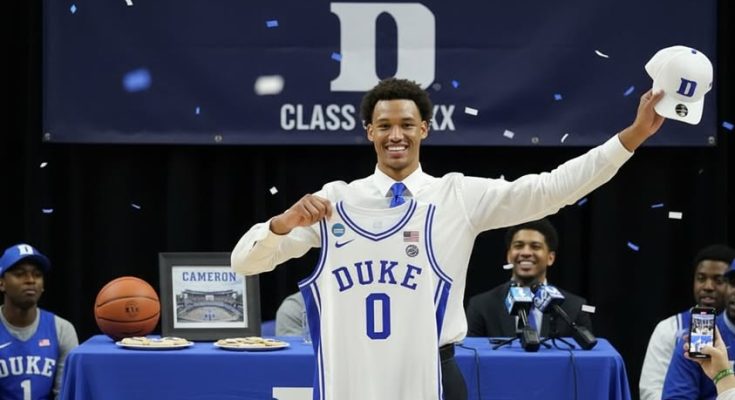Top basketball recruit shocks fans, declining offers from Alabama Crimson Tide, Arkansas Razorbacks, and Kentucky Wildcats, officially committing to Duke. Men’s college basketball buzzes as Duke’s basketball program continues to assert its dominance in recruiting, reaffirming its status as one of the nation’s most desirable destinations for elite talent. The commitment has not only sent waves through the college basketball landscape but also sparked intense discussion among analysts, coaches, and fans alike about what this means for the balance of power in the NCAA.
The young star in question, a generational talent ranked among the top players in his class, had been heavily pursued by several powerhouse programs. Alabama, Arkansas, and Kentucky all made aggressive pushes to secure his signature, each promising a system built around his skillset and a fast track to NBA development. Yet when the moment came for his announcement, the decision was clear and emphatic: Duke University. The choice stunned many who had followed his recruitment closely, as most projections had leaned toward Kentucky or Alabama in recent weeks.
The announcement came during a nationally televised segment, with the recruit surrounded by family, teammates, and coaches. Wearing a calm smile, he lifted a blue Duke cap and placed it on his head — a symbolic gesture that instantly lit up social media. Within minutes, “Duke” was trending across multiple platforms, with fans celebrating and rival fanbases expressing disbelief. In a recruiting cycle already filled with surprises, this one stood above the rest — not just because of who committed, but because of who was left behind.
For Alabama, the loss stings deeply. The Crimson Tide, who have been steadily building a strong basketball culture under head coach Nate Oats, saw this commitment as a chance to add another elite piece to their emerging national contender. With multiple high-level recruits already on their roster, Alabama was hoping to make a serious push for a Final Four appearance. Landing the top recruit would have solidified them as a consistent national powerhouse. But Duke’s pull — its tradition, its coaching, and its proven track record of producing NBA talent — proved irresistible.
Arkansas, too, had placed significant emphasis on this recruitment. The Razorbacks, known for their passionate fan base and intense playing style, had offered the recruit the chance to be the face of their program. Head coach John Calipari, now at Arkansas after his celebrated tenure at Kentucky, had made it clear that this young star was his top priority. Many believed that Calipari’s reputation as a recruiter of NBA-level talent would sway the decision. After all, Calipari’s history with one-and-done superstars like John Wall, Anthony Davis, and Devin Booker still resonates with recruits. However, this time, the momentum shifted away from him, as Duke’s message of stability, brotherhood, and player development hit home at the right moment.
Kentucky’s fans, perhaps the most stunned of all, have taken this loss particularly hard. The Wildcats had been considered favorites early in the process, especially after several glowing interviews and visits. Kentucky, long regarded as the gold standard in college basketball recruiting, suddenly finds itself being outmaneuvered by Duke on multiple fronts. Once the undisputed leader in attracting top-tier recruits, Kentucky has faced increasing competition from other elite programs. This latest decision reinforces a growing sentiment that Duke, under head coach Jon Scheyer, is now the premier destination for America’s best high school talent.
For Duke, this commitment represents more than just another addition to an already loaded roster. It symbolizes continuity in excellence. Ever since Jon Scheyer took over from Mike Krzyzewski, questions have swirled about whether Duke could maintain its recruiting dominance without its legendary coach. Those questions now seem laughable. Scheyer has not only maintained Duke’s momentum — he has amplified it. In the last few recruiting cycles, Duke has consistently landed multiple five-star prospects, building a roster capable of competing for a national title every year.
The program’s pitch is simple but effective: elite competition, elite development, and a culture of accountability. Duke doesn’t just produce NBA players — it produces professionals who understand the game, the pressure, and the expectations that come with greatness. For young players dreaming of the next level, that message carries tremendous weight. The newest Blue Devil recruit cited this very factor in his post-announcement interview, saying, “Duke just felt like home. It’s a place where I can grow — not just as a player, but as a person. I want to be part of something bigger than myself, and Duke gives me that.”
His words resonate with the ethos that has long defined Duke basketball. The brotherhood — a term that captures the shared bond among current players and alumni — is more than a slogan. It’s a living, breathing network that connects generations of athletes. From Grant Hill and Shane Battier to Zion Williamson and Paolo Banchero, Duke’s lineage speaks for itself. That heritage has a gravitational pull few programs can match.
The implications of this commitment extend far beyond Duke’s campus. In the ever-evolving world of college basketball, recruiting battles are often as decisive as games themselves. Landing a single elite recruit can shift a program’s trajectory, altering not just its immediate prospects but also its perception among future players. For Duke, every successful commitment builds momentum, creating a virtuous cycle of attraction and success. For their rivals, each missed opportunity fuels the urgency to adapt, innovate, and respond.
Analysts are already speculating about how this recruit will fit into Duke’s system. Standing at 6-foot-8 with elite athleticism, versatile scoring ability, and strong defensive instincts, he is the type of player who thrives in Duke’s motion offense. His combination of size, skill, and court vision makes him a potential matchup nightmare for opponents. Some scouts have compared him to former Duke stars like Jayson Tatum or Brandon Ingram — players who entered the program with raw talent and left as polished NBA-ready prospects.
Duke’s coaching staff is reportedly thrilled by what this addition means for the team’s future. Scheyer, known for his calm demeanor and tactical precision, now has yet another dynamic weapon to deploy. Paired with other elite recruits already committed for the upcoming season, Duke’s roster looks every bit like a championship contender. The Blue Devils’ ability to blend experienced returners with incoming freshmen gives them a balance that few teams can replicate.
Recruiting experts point to several factors that ultimately swung the decision Duke’s way. Chief among them was the university’s emphasis on development beyond basketball. Duke’s academic reputation, combined with its emphasis on leadership and life skills, appealed strongly to the player’s family. His parents, both advocates for education and discipline, reportedly played a key role in guiding him toward a school that values more than just athletic performance.
Additionally, Duke’s NIL (Name, Image, and Likeness) strategy has evolved into one of the most organized and effective in college basketball. The program’s partnerships and alumni network allow players to build their personal brands responsibly while maintaining focus on their game. For a player of this magnitude, with millions of potential social media followers and future endorsement opportunities, that structure is invaluable.
While the immediate reaction from rival fanbases has been disappointment, there’s an underlying recognition that this decision makes sense. Duke’s consistency, visibility, and pathway to the NBA are unmatched. Over the last decade, few programs have sent as many players to the professional ranks, and those players often thrive at the next level. That success reinforces the cycle, ensuring that future stars continue to look to Durham as the ideal launchpad for their careers.
Within the college basketball community, the buzz around this commitment has reinvigorated conversations about the sport’s shifting power dynamics. Once dominated by Kentucky and Kansas, the recruiting landscape has become more competitive. Alabama’s emergence as a serious basketball power, coupled with the resurgence of programs like Arkansas and UConn, has diversified the field. Yet Duke remains at the center of it all — a constant presence in Final Four discussions and a perennial favorite in every preseason ranking.
For fans, this moment is a reminder of why college basketball remains so compelling. Beyond the games, beyond the tournaments, it’s the stories — the choices, the surprises, the dreams realized — that keep people watching. A young man choosing his path, weighing tradition against opportunity, and ultimately committing to a program that aligns with his vision for greatness captures the essence of what makes the sport so magnetic.
As for Duke, the focus now shifts to the future. The countdown to next season has already begun, with fans eagerly anticipating the debut of their newest star. Expectations will be sky-high, as they always are in Durham. But for this recruit, the pressure is nothing new. He’s spent his entire high school career under the spotlight, facing expectations, scrutiny, and praise in equal measure. Now, with his decision made, he can channel that energy into preparation — ready to step into Cameron Indoor Stadium and add his name to the storied history of Duke basketball.
College basketball’s landscape may evolve year by year, but some things remain constant: talent gravitates toward tradition, and champions are built where excellence is expected. This commitment is another chapter in that ongoing story — a testament to Duke’s enduring power and the magnetic pull of its blue and white legacy. As the echoes of this announcement continue to reverberate across the country, one thing is clear: in the race for college basketball supremacy, Duke is not just keeping pace — it’s setting the standard.



